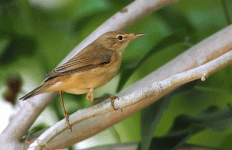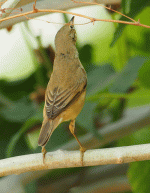-
Welcome to BirdForum, the internet's largest birding community with thousands of members from all over the world. The forums are dedicated to wild birds, birding, binoculars and equipment and all that goes with it.
Please register for an account to take part in the discussions in the forum, post your pictures in the gallery and more.
You are using an out of date browser. It may not display this or other websites correctly.
You should upgrade or use an alternative browser.
You should upgrade or use an alternative browser.
which reed warbler - Jeddah (1 Viewer)
- Thread starter ammadoux
- Start date
More options
Who Replied?AlinoVegano
Well-known member
Yeah, Caspian feeling here, let's see if we can have expert advice.
ammadoux
Registered doux
I given the location, fantastic shots btw! Are the images recent?
Cheers
all shot were taken on the 24th of May 2017.
Tib78
Well-known member
It does seem to be a bird from the A.scirpaceus complex, but with such a short primary projection and richly coloured plumage, is fuscus really the best candidate here? Ssp fuscus is (supposed to be) a dull grey-brown, not particularly short-winged reed warbler. Also the "kink" on the wing on the first shot probably marks the position of the emargination of P3, which looks to fall short of the secondarird tips...it is usually a sign that P4 is (at least slightly) emarginated.
All this does not fit fuscus very well I'd say. I'd rather look in the direction of Mangrove or even African reed warbler.
All this does not fit fuscus very well I'd say. I'd rather look in the direction of Mangrove or even African reed warbler.
Andy Adcock
Worst person on Birdforum

It does seem to be a bird from the A.scirpaceus complex, but with such a short primary projection and richly coloured plumage, is fuscus really the best candidate here? Ssp fuscus is (supposed to be) a dull grey-brown, not particularly short-winged reed warbler. Also the "kink" on the wing on the first shot probably marks the position of the emargination of P3, which looks to fall short of the secondarird tips...it is usually a sign that P4 is (at least slightly) emarginated.
All this does not fit fuscus very well I'd say. I'd rather look in the direction of Mangrove or even African reed warbler.
The colour doesn't look quite right to me, I wonder how accurate it is?
I get colours like that in pics taken in late afternoon sun?
A
KenM
Well-known member
The pp appears to be 1/3 of overlying tertials which is within the accepted variance (66%) for A.scirp. There are a number of examples very similar (rich warm tones), shown on the web for fuscus, and I suspect that it "mirrors" other RW that occur in Spring within the region. That being said...I have never been to the area, and am relying on images shown on the web purporting to show Caspian Reed Warbler, the emargination on p3 falling "outside" the tertial area...I believe conforms to general RW wing biometrics.
Nutcracker
Stop Brexit!
Strikes me as very short-tailed compared to UK Reed Warblers - is that significant in its specific / subspecific identity?
Bryon Wright
Well-known member
Hi all,
Ammodaux a bit perplexed you have been lucky to study Mangrove Reed Warblers. What makes you think Caspian Warbler which is very variable?
Ammodaux a bit perplexed you have been lucky to study Mangrove Reed Warblers. What makes you think Caspian Warbler which is very variable?
ammadoux
Registered doux
Hi all,
Ammodaux a bit perplexed you have been lucky to study Mangrove Reed Warblers. What makes you think Caspian Warbler which is very variable?
i forgot about the mangrove reed, but yes this is the time when they come to the region and start breeding.
but i am still confused MRW usually have longer bill.
ammadoux
Registered doux
got these shot for the mangrove reed.
http://www.birdforum.net/gallery/showphoto.php/photo/420563/ppuser/71763
http://www.birdforum.net/gallery/showphoto.php/photo/421276/ppuser/71763
http://www.birdforum.net/gallery/showphoto.php/photo/504371/ppuser/71763
this shot i got it last year at almost the same time, but i thought its the Eurasian.
http://www.birdforum.net/gallery/showphoto.php/photo/557348/ppuser/71763
what do you think.
http://www.birdforum.net/gallery/showphoto.php/photo/420563/ppuser/71763
http://www.birdforum.net/gallery/showphoto.php/photo/421276/ppuser/71763
http://www.birdforum.net/gallery/showphoto.php/photo/504371/ppuser/71763
this shot i got it last year at almost the same time, but i thought its the Eurasian.
http://www.birdforum.net/gallery/showphoto.php/photo/557348/ppuser/71763
what do you think.
AlinoVegano
Well-known member
got these shot for the mangrove reed.
http://www.birdforum.net/gallery/showphoto.php/photo/420563/ppuser/71763
http://www.birdforum.net/gallery/showphoto.php/photo/421276/ppuser/71763
http://www.birdforum.net/gallery/showphoto.php/photo/504371/ppuser/71763
this shot i got it last year at almost the same time, but i thought its the Eurasian.
http://www.birdforum.net/gallery/showphoto.php/photo/557348/ppuser/71763
what do you think.
I think that your photos are fabulous! :t:
ammadoux
Registered doux
:loveme::flowers:
I think that your photos are fabulous! :t:
KenM
Well-known member
I think that your photos are fabulous! :t:
I agree with this sentiment ammadoux :t: Regarding the last image...Why Isn't it a Marsh Warbler, very long pp, with contrasting tips, and a relatively short bill?
Cheers
Users who are viewing this thread
Total: 2 (members: 0, guests: 2)





